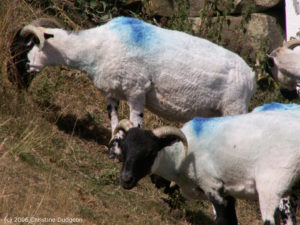Raddle/Keel Marks
1 February 2017Throughout tupping you will have conscientiously changed the raddle or keel colour of the tup every 10 or 17 days, now the task is to ensure you use this to your advantage. The colours on the sheep’s bums give you a huge amount of knowledge at tupping time, eg if the tup is fit for the job or not, managing to mount, being interested, covering the ewes, etc. But these colours can now aid efficiency at lambing time.
Benefit 1
Imagine the tup has covered 80 ewes, with 85% of these holding to first cycle (68 ewes). A further 8 held to second cycle and the final 4 who have a multitude of colours on their back sides. You straight away know that calling the scanner in 70-100 days from the tups being introduced to the ewes, will allow for the majority of ewes to be on target for scanning date, resulting in a high accuracy for scanning.
Benefit 2
The second benefit will be pre lambing when feeding is introduced. If you are feeding 75kg mule ewes with average ad lib silage and concentrates at 0.6kg/hd/day over 4 weeks (28 days x 0.6kg = 16.80kg/head x 80 ewes = 1,344 tonnes @ £210/tonne), this would cost approximately £282.24. The 12 later lambing ewes would keep receiving feed for another 3 weeks increasing this cost by £31.71. This has an obvious knock on cost on your margins but also an over supply of energy and protein to the ewe. This can result in her becoming overfat and laying muscle down in her pelvis, making less room available in the birth canal, her muscles would be weaker for being more fatty and the lambs would have a greater birth weight possibly adding to the problem.
Benefit 3
The third benefit will be when housing ewes. The 12 later lambing ewes would not need housed until they were closer to lambing, resulting in a lower stocking density in house. This would allow for benefits such as adequate trough space, reduced bullying, reduced ammonia and a reduction of disease build up and less ewes to watch.
Using the raddle/keel marks on the ewes allows for cost savings and efficiency, particularly when scanning is carried out.
Kirsten Williams, kirsten.williams@sac.co.uk
Sign up to the FAS newsletter
Receive updates on news, events and publications from Scotland’s Farm Advisory Service

